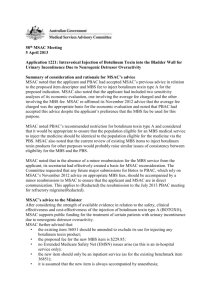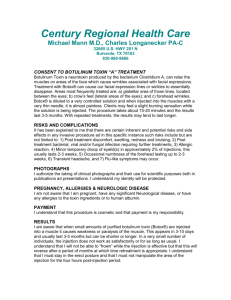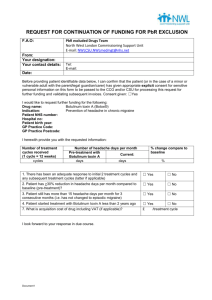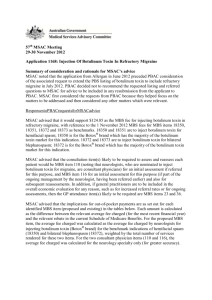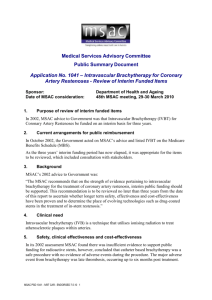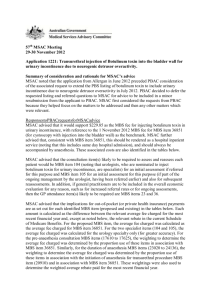Public Summary Document - the Medical Services Advisory Committee
advertisement
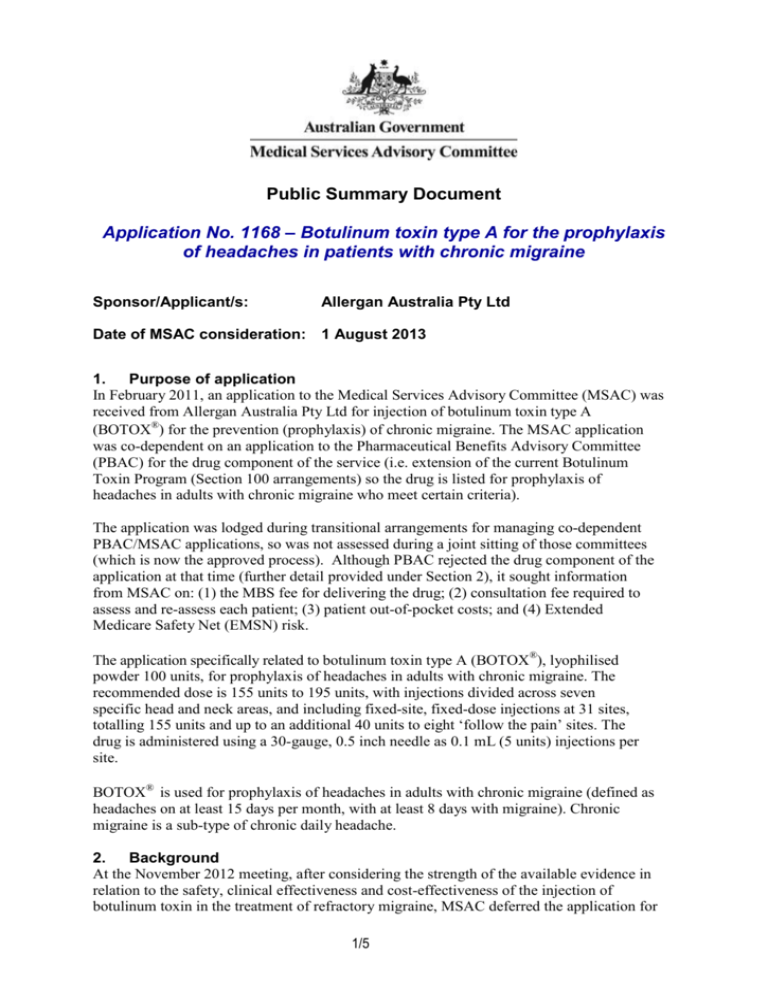
Public Summary Document Application No. 1168 – Botulinum toxin type A for the prophylaxis of headaches in patients with chronic migraine Sponsor/Applicant/s: Allergan Australia Pty Ltd Date of MSAC consideration: 1 August 2013 1. Purpose of application In February 2011, an application to the Medical Services Advisory Committee (MSAC) was received from Allergan Australia Pty Ltd for injection of botulinum toxin type A (BOTOX®) for the prevention (prophylaxis) of chronic migraine. The MSAC application was co-dependent on an application to the Pharmaceutical Benefits Advisory Committee (PBAC) for the drug component of the service (i.e. extension of the current Botulinum Toxin Program (Section 100 arrangements) so the drug is listed for prophylaxis of headaches in adults with chronic migraine who meet certain criteria). The application was lodged during transitional arrangements for managing co-dependent PBAC/MSAC applications, so was not assessed during a joint sitting of those committees (which is now the approved process). Although PBAC rejected the drug component of the application at that time (further detail provided under Section 2), it sought information from MSAC on: (1) the MBS fee for delivering the drug; (2) consultation fee required to assess and re-assess each patient; (3) patient out-of-pocket costs; and (4) Extended Medicare Safety Net (EMSN) risk. The application specifically related to botulinum toxin type A (BOTOX®), lyophilised powder 100 units, for prophylaxis of headaches in adults with chronic migraine. The recommended dose is 155 units to 195 units, with injections divided across seven specific head and neck areas, and including fixed-site, fixed-dose injections at 31 sites, totalling 155 units and up to an additional 40 units to eight ‘follow the pain’ sites. The drug is administered using a 30-gauge, 0.5 inch needle as 0.1 mL (5 units) injections per site. BOTOX® is used for prophylaxis of headaches in adults with chronic migraine (defined as headaches on at least 15 days per month, with at least 8 days with migraine). Chronic migraine is a sub-type of chronic daily headache. 2. Background At the November 2012 meeting, after considering the strength of the available evidence in relation to the safety, clinical effectiveness and cost-effectiveness of the injection of botulinum toxin in the treatment of refractory migraine, MSAC deferred the application for 1/5 an MBS item to inject botulinum toxin until such time that PBAC had made a decision regarding the corresponding PBS listing of botulinum toxin. On behalf of MSAC, the Department suggested that Allergan lodge a “minor submission" to the August 2013 MSAC meeting for the MBS listing of the procedure to inject botulinum toxin Type A in chronic migraine in order for it to align with the resubmission to the July 2013 PBAC meeting for the Pharmaceutical Benefits Scheme (PBS) listing of botulinum toxin Type A for chronic migraine. At its July 2013 meeting, PBAC recommended extending the current Section 100 Botulinum Toxin Program listing for botulinum toxin type A to include prophylaxis of headaches in adult patients with chronic migraine who meet certain criteria, on the basis of acceptable cost-effectiveness compared to best supportive care. 3. Prerequisites to implementation of any funding advice TGA approved BOTOX® for the prophylaxis of headaches in adults with chronic migraine (headaches on at least 15 days per month, of which at least 8 days are with migraine) on 15 March 2011. 4. Proposal for public funding The proposed listing is shown in the table below. The requested fee was $124.85 (with reference to the 1 November 2012 MBS fees for MBS items 18350, 18351, 18372 and 18373 as benchmarks). Proposed wording and fee for the requested MBS item Group T11 – Botulinum toxin Division 2.42A of the General Medical Services Table MBS item no: TBA (within Group T11) BOTULINUM TOXIN (Botox), injection of, for the prophylaxis of headaches in adults with chronic migraine who have failed at least three migraine prophylactic medications, in accordance with supply of the drug under instrument PB 122 of 2008 (Arrangements – Botulinum Toxin Program) made under Section 100 (1) (b) of the National Health Act 1953. (See para T11.1 of explanatory notes to this Category) Fee: $124.85 5. Nil Consumer Impact Statement 6. Proposed intervention’s place in clinical management There is no current alternative treatment on the MBS. This would be an additional intervention on the MBS. Best supportive care is available where other treatments have failed (i.e. where patients have not responded to migraine-prophylactic medications). 2/5 7. Nil Other options for MSAC consideration 8. Comparator to the proposed intervention MSAC had previously agreed, in November 2012, that best supportive care (BSC) was the appropriate comparator. 9. Comparative safety MSAC had previously agreed, in November 2012, that the injection method to deliver Botox® for migraine appears no more or less safe than the injection method to deliver Botox® under existing MBS-listed items. 10. Comparative effectiveness MSAC had previously agreed, in November 2012, that the injection method to deliver Botox® for migraine appears no more or less effective than the injection method to deliver Botox® under existing MBS-listed items. 11. Economic evaluation MSAC noted that economic evaluation of the cost-effectiveness of Botox® treatment for chronic migraine was considered by PBAC at its July 2013 meeting. The resubmission presented a modelled cost utility analysis (CUA), updated to reflect the changed continuation criteria, updated botulinum toxin administration costs (in line with MSAC advice) and inclusion of disutility for adverse events. The base case ICER was between $15,000 - $45,000/QALY, based on individual patient headache day data from the PREEMPT trials. MSAC noted that PBAC considered the calculated base case ICER was acceptable, but would only be reflected in practice if the assumptions and conditions used in the model were translated into practice. 12. Financial/budgetary impacts The likely number of treatments per year estimated in the MSAC resubmission was less than 30,000 in Year 5. MSAC noted this estimate had increased compared to the previous submission. The total net cost to the MBS was estimated in the MSAC resubmission to be less than $5 million over the first 5 years. MSAC noted this estimate had increased compared to the previous submission due to an increase in the estimated number of treatments. 13. Key issues for MSAC from ESC Nil 14. Other significant factors Nil 15. Summary of consideration and rationale for MSAC’s advice MSAC noted that the July 2013 PBAC meeting had recommended botulinum toxin type A (Botox®) for a new listing on the PBS, and had recommended this listing to include the prophylaxis in adult patients with chronic migraine who meet certain criteria. MSAC 3/5 reaffirmed the importance of aligning the new MBS item descriptor defining the population of patients eligible to be injected with the medicine with the new PBS restriction. MSAC decided that there were no new issues for it to consider in relation to the safety and effectiveness of the injection service given that there are existing MBS items for Botox ® injection and MSAC had recently considered Botox® injection in November 2012 in relation to neurogenic detrusor overactivity (application 1221) and refractory migraine (application 1168). MSAC noted consumer support for this listing as another treatment option, including for it to be reserved to a later line of therapy because of the invasive nature of its administration and its modest improvement in managing chronic refractory migraine. MSAC reaffirmed its November 2012 advice that the MBS fee for injecting botulinum toxin in refractory migraine be $124.85, with reference to the 1 November 2012 MBS fees for MBS items 18350, 18351, 18372 and 18373 as benchmarks. MSAC recalled its November 2012 intention to advise that a cap should apply to the MBS item for the purposes of the Extended Medicare Safety Net (EMSN), reflecting the estimate of four injections per patient per year, and agreed that the details of these arrangements were a policy matter for the Department. MSAC noted the applicant’s estimates of financial implications to the MBS were less than $5 million in each year of listing and that these did not include any EMSN consequences. MSAC advised against the option of excluding the billing of attendance items to assess or reassess the patient on the same occasion of service as the proposed item for injecting the medicine for migraine prophylaxis, especially for subsequent injections. MSAC came to this conclusion because the setting for a neurologist consultation is the same as the setting for a neurologist injecting Botox® to prevent migraine, and therefore it is harder to separate them for billing purposes. In making this statement MSAC recalled that its April 2013 advice, for intravesical injection of Botox® into the bladder wall for urinary incontinence due to neurogenic detrusor overactivity, had advised against allowing urologists to claim a consultation MBS item on the same day as the proposed MBS item for injecting the Botox® because this service is performed in an in-patient hospital setting. 16. MSAC’s advice to the Minister After considering the strength of the available evidence in relation to the safety, clinical effectiveness and cost-effectiveness of injecting botulinum toxin type A (Botox®) in refractory chronic migraine, MSAC supports its public funding via a new MBS item, with an MBS fee of $124.85 and an item descriptor, aligned with the PBS restriction, of: Botulinum toxin type A (Botox®), injection of, including all injections in one day, for the treatment of chronic migraine if: (a) the patient is an adult; and (b) the patient has experienced an inadequate response, intolerance or a contraindication to at least three prophylactic migraine medications prior to commencement of treatment with botulinum toxin as manifested by an average of 15 or more headache days per month, with at least 8 days of migraine, over a period of at least 6 months, prior to commencement of treatment with botulinum toxin; and (c) the requirements relating to botulinum toxin type A under the Pharmaceutical Benefits Scheme are complied with; and 4/5 (d) treatment is only continued if the patient achieves and maintains a 50% or greater reduction from baseline in the number of headache days per month after two treatment cycles (each of 12 weeks duration). 17. Applicant’s comments on MSAC’s Public Summary Document No comment. 18. Context for decision This advice was made under the MSAC Terms of Reference. MSAC is to: Advise the Minister for Health and Ageing on medical services that involve new or emerging technologies and procedures and, where relevant, amendment to existing MBS items, in relation to: the strength of evidence in relation to the comparative safety, effectiveness, costeffectiveness and total cost of the medical service; whether public funding should be supported for the medical service and, if so, the circumstances under which public funding should be supported; the proposed Medicare Benefits Schedule (MBS) item descriptor and fee for the service where funding through the MBS is supported; the circumstances, where there is uncertainty in relation to the clinical or costeffectiveness of a service, under which interim public funding of a service should be supported for a specified period, during which defined data collections under agreed clinical protocols would be collected to inform a re-assessment of the service by MSAC at the conclusion of that period; other matters related to the public funding of health services referred by the Minister. Advise the Australian Health Ministers’ Advisory Council (AHMAC) on health technology assessments referred under AHMAC arrangements. MSAC may also establish sub-committees to assist MSAC to effectively undertake its role. MSAC may delegate some of its functions to its Executive sub-committee. 19. Linkages to other documents MSAC’s processes are detailed on the MSAC Website at: www.msac.gov.au. 5/5
